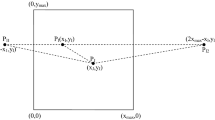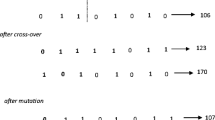Abstract
In this paper, we introduce four new benchmark problems, which are based on rather common optimization issues of water resources management. These problems have the following features: a) adjustable difficulty, to cover a wide range of common engineering problems b) physical background familiar to scientists working on water resources management c) known global optimal solution and known range of values of the objective function d) easy application and e) low computational volume (analytical solution of the respective groundwater flow model). First we calculate the optimal solutions of these problems and then we evaluate their difficulty and their suitability as benchmarking tools, based on theoretical considerations and on the performance of a genetic algorithm and a simulated annealing code in finding their optimal solutions. Results show that the proposed set of benchmark problems is useful for evaluating heuristic optimization codes in the field of water resources management.



Similar content being viewed by others
References
Ali MM, Khompatraporn C, Zabinsky ZB (2005) A numerical evaluation of several stochastic algorithms on selected continuous global optimization test problems. J Global Optim 31(4):635–672
Bear J (1979) Hydraulics of Groundwater. McGraw-Hill.
Cerny V (1985) Thermodynamical approach to the travelling salesman problem: An efficient simulation algorithm. J Optim Theory Appl 45:41–51
Chiu Y-C, Nisshikawa T, Yeh WW-G (2010) Optimal Pump and Recharge Management Model for Nitrate Removal in the Warren Groundwater Basin. California J Water Resour Plann Manage 136(3):299–308
Cunha MC (2003) On Solving Aquifer Management Problems with Simulated Annealing Algorithms. Water Resour Manage 13:153–170
Deb K, Saha A (2010) Finding multiple solutions for multimodal optimization problems using multiobjective evolutionary approach. GECCO 2010:447–454
Dolan ED, Moré JJ (2002) Benchmarking optimization software with performance profiles. Math Program 91:201–213
Floudas CA, Pardalos PM (eds.) 2008 Encyclopedia of Optimization. 2nd edn. Kluwer Academic Publishers.
Floudas CA, Pardalos PM, Adjiman C, Esposito W, Gümüs Z, Harding S, Klepeis J, Meyer C, Schweiger C (1999) Handbook of Test Problems in Local and Global Optimization. Kluwer Academic Publishers, Dordrecht
Fragoso T, Cunha MC, Lobo-Ferreira JP (2009) Optimal pumping from Palmela water supply wells (Portugal) using simulated annealing. Hydrogeol J 17(8):1935–1948
Gaviano M, Kvasov DE, Lera D, Sergeyev YD (2003) Algorithm 829: Software for generation of classes of test functionswith known of local and global minima for global optimization. ACM Trans Math Softw 29(4):469–480
Goldberg DE (2002) Design of innovation: lessons from and for competent genetic algorithms. Springer.
Ingber L (1993) Simulated annealing: practice versus theory. Math Comput Modell 18:29–57
Ji M, Jin Z, Tung H (2006) An improved simulated annealing for solving the linear constrained optimization problems. Appl Math Comput 183:251–259
Katsifarakis KL, Tselepidou K (2009) Pumping cost minimization in aquifers with regional flow and two zones of different transmissivities. J Hydrol 377(1–2):106–111
Katsifarakis KL, Karpouzos DK, Theodossiou N (1999) Combined use of BEM and genetic algorithms in groundwater flow and mass transport problems. Engin Anal Bound Elem 23(7):555–565
Kirkpatrick S, Gelatt CD, Vecchi MP (1983) Optimization by Simulated Annealing. Sci 4598:671–680
Kollat JB, Reed PM (2006) Comparison of multi-objective evolutionary algorithms for long-term monitoring design. Adv Water Resour 29(6):792–807
Koon GH, Sebald AV (1995) Some interesting test functions for evaluating evolutionary programming strategies. Proc fourth Annual Conf on Evolut. Program, San Diego, California, 1-3 March 1995, Evolutionary Programming IV, MIT Press, 479-499.
Liu JS, Caley AJ, Waddie AJ, Taghidech MR (2008) Comparison of simulated quenching algorithms for design of diffractive optical elements. Appl Opt 47(6):807–816
Matott LS, Bartelt-Hunt SL, Rabideau AJ, Fowler KR (2006) Application of heuristic optimization techniques and algorithm tuning to multilayered sorptive barrier design. Environ Sci Technol 40:6354–6360
Mayer AS, Kelley CT, Miller CT (2002) Optimal design for problems involving flow and transport in saturated porous media. Adv Water Resour 12:1233–1256
Nam D, Lee JS, Park CH (2004) N-dimensional Cauchy neighbour generation for the Fast Simulated Annealing. IEICE Trans Inf Syst E87-D(11):2499–2502
Reeves CR, Raw JE (2003) Genetic algorthms-Principles and perspectives. Kluwer Academic Publishers.
Shcherbina O, Neumaier A, Sam-Haroud D, Vu XH, Nguyen TV (2003) Benchmarking global optimization and constraint satisfaction codes. In: Global Optimization and Constraint Satisfaction. Lecture Notes in Computer Science 2861:211–222
Singh G, Deb K (2006) Comparison of multi-modal optimization algorithms based on evolutionary algorithms. GECCO 2006:1305–1312
Suman B, Kumar P (2006) A survey of simulated annealing as a tool for single and multiobjective optimization. J Oper Res Soc 57:1143–1160
Tang Y, Reed PM, Kollat JB (2007) Parallelization strategies for rapid and robust evolutionary multiobjective optimization in water resources applications. Adv Water Res 30:335–353
Teegavarapur RSV, Simonovic SP (2002) Optimal Operation of Reservoir Systems using Simulated Annealing. Water Resour Manage 16:401–428
Tsai FTC, Katiyar V, Toy D, Goff RA (2009) Conjunctive Management of Large-Scale Pressurized Water Distribution and Groundwater Systems in Semi-Arid Area with Parallel Genetic Algorithm. Water Resour Manage 23:1497–1517
Wolpert DH, Macready WG (1997) No free lunch theorems for optimization. IEEE Trans Evol Comput 1(1):67–82
Wu ZY, Walski T (2005) Self-adaptive penalty approach compared with other constraint-handling techniques for pipeline optimization. J Water Resour Plann Manage 131(3):181–192
Yang WY, Cao W, Chung TS, Morris J (2005) Applied numerical methods using Matlab. Hoboken, New Jersey, John Wiley & Sons, Inc
Younis A, Dong Z (2010) Trends, features, and tests of common and recently introduced global optimization methods. Eng Optim 42(8):691–718
Youssef H, Sait SM, Adiche H (2001) Evolutionary algorithms, simulated annealing and tabu search: a comparative study. Eng Appl Artif Intell 14(2):167–181
Author information
Authors and Affiliations
Corresponding author
Rights and permissions
About this article
Cite this article
Karpouzos, D.K., Katsifarakis, K.L. A Set of New Benchmark Optimization Problems for Water Resources Management. Water Resour Manage 27, 3333–3348 (2013). https://doi.org/10.1007/s11269-013-0350-z
Received:
Accepted:
Published:
Issue Date:
DOI: https://doi.org/10.1007/s11269-013-0350-z




